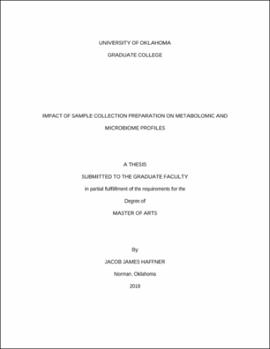| dc.description.abstract | Anthropological studies of human biology are predominately field-based, and burdened, by the need for well-preserved biological samples. In the emerging application of multi-omics, definitions of “well-preserved” and preservation strategies have had limited study, particularly those data that inform the biology of the human ecology. These human ecological data are a frequent objective of metabolomics and microbiome research. Metabolomics, through exploration of the totality of small molecules known as metabolites, offers a way to directly observe the molecular phenotype. These small molecules offer just as much valuable information to molecular anthropology as DNA and RNA, but there is a surprising lack of inquiry into how these molecules are preserved in samples and how molecular preservation impacts results and interpretations. For most metabolomic studies, the standard sample collection procedure involves snap-freezing the sample within 15 minutes of collection and storing at -80ºC. However, this is often unfeasible for field-based sample collection. Metabolome taphonomy, the study of how metabolome profiles are impacted by environmental processes as well as sample collection and preservation/preparation strategies, is still poorly understood. This thesis considers sample storage, with attention to human gut microbial samples. Consequently, this thesis presents two complementary studies, one with a focus on the metabolome and one focused on the microbiome taxonomic inventory, to determine if the application of the common DNA and RNA preservative RNAlater provides a valuable method for conserving ecological data from both approaches. Ten human fecal samples previously collected and frozen at -80ºC were homogenized, aliquoted, and subjected to treatment that simulates different levels of cold storage in the field: 22-25ºC, 4ºC, and -80ºC. To assess the impact of preservation methods on metabolite and bacterial taxonomic profiles, subsets of these aliquots were further treated with different preservation techniques, such as RNAlater. Metabolomic and bacterial taxonomic profiles were characterized using liquid chromatography-tandem mass spectrometry and 16S rRNA amplicon sequencing, respectively. These results will inform field sample collection and best storage practices for human biological approaches that apply multi-omic studies. | en_US |

